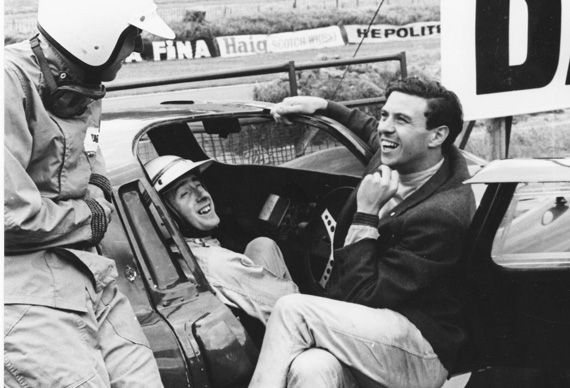
Recalling the early days: British Grand Prix support race 1964, Jackie Stewart at the wheel of the Ecurie Ecosse Tojeiro-Ford gets some last minute advice from Jim Clark with eventual race winner Hugh Dibley at left. At Holyrood House, 2015, Jackie Stewart was the guest of honor.
Story and Photos by Graham Gauld
A visit back to my hometown of Edinburgh always brings back a series of memories from the days when David Murray first started the successful Ecurie Ecosse team, to the early racing days of Jim Clark, Jackie Stewart and Dario Franchitti.
As can be seen elsewhere the main Concours of Elegance held at the Palace of Holyrood House – to give it its full title – attracted a remarkable collection of cars owned by some of the most important collectors from the U.S.A., Britain and Europe as can be seen in Jonathan Sharp’s fine photographs.
However, as the event was being held in Scotland the organizers wanted to showcase a variety of cars linked to Scottish motor racing drivers and teams, particularly Ecurie Ecosse, the team first created by David Murray in
1952. Ecurie Ecosse would be a racing stable that could claim to be one of the most successful, truly private teams to win at Le Mans. With their D-Type Jaguars Ecurie Ecosse won the race in 1956 and then surprised everyone by going back in 1957 and finishing first and second at Le Mans, again with D-Type Jaguars.
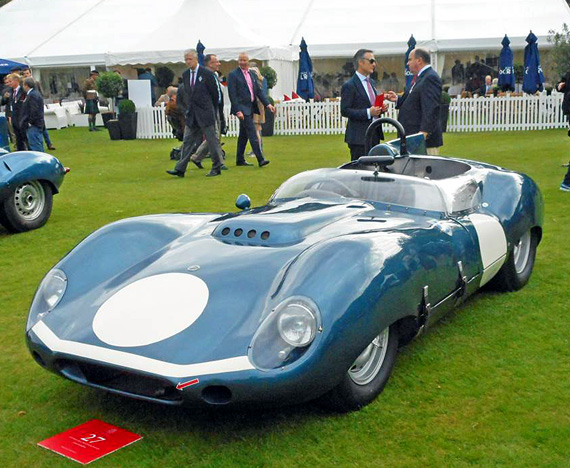
Another Ecurie Ecosse car, the Tojeiro-Jaguar shared by the late Jim Clark and Masten Gregory in the 1959 Tourist Trophy race at Goodwood.
One of the cars on show was the second-place D-Type now owned by English collector Clive Beecham who also owns the 1961 Tourist Trophy winning Ferrari 250GT SWB driven by Stirling Moss. Clive has amassed a huge amount of data on the background to his D-Type, which had a chequered career which included being split into two and then put together again. This was thanks to Ecurie Ecosse veteran mechanic Stan Sproat (who is now 90 years of age), using the meticulous notes he kept in a series of notebooks. In total there were around eight former Ecurie Ecosse cars either in the Concours itself or in the special display of notable Scottish racing cars.
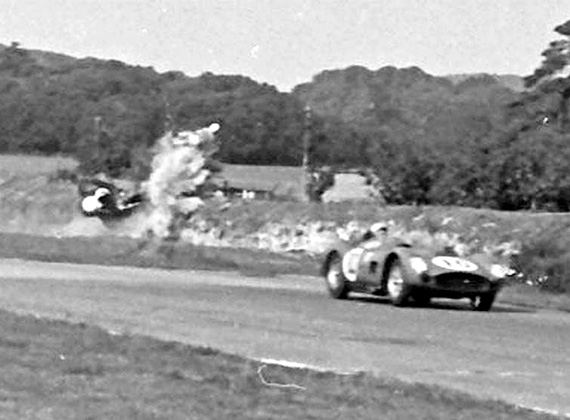
The end result, Masten hits the banking at Goodwood but having stood up on the seat he was projected through the air and broke his collar bone. Olivier Gendebien heads on with his TR59.
One of those was the Tojeiro-Jaguar notably remembered as the car destroyed by Masten Gregory during the 1959 Tourist Trophy Race at Goodwood. I was at the event and witnessed the crash. On the approach to Woodcote Corner Gregory came round the outside of Olivier Gendebien’s Ferrari TR59 and then shot across the grass and speared the high banking. Masten was thrown up into the air and was lucky to break his collarbone in a fearful accident. I remember discussing the event with Gendebien and he remarked “…I was braking for Woodcote and out of the corner of my eye I saw a blue car come alongside me and couldn’t believe that anyone would overtake me on the outside at that spot. I glanced over and could not believe my eyes because Masten was clearly struggling to stand up on the seat and he shot across the track and into the banking without slowing down.” Gregory had once before done the same thing for in those days of no seat belts he felt it was better to be thrown out of the car than stay in, so when the car hit the bank he was thrown clear as my photo from about 50 yards away shows.
However, there was another interesting sidelight to that car and Masten. His co-driver on that occasion was Gregory’s hero Jim Clark. During practice Clark had wrestled with the Tojeiro and recalled that described its handling as being “up on its tip toes”. Eighteen months before Gregory had lapped Clark at Spa and Clark had been amazed at Gregory’s speed and felt he would never be able to drive as fast as that. Now at Goodwood he had been quicker than his hero and never looked back.
Today the Tojeiro is owned by James Cottingham whose father, David Cottingham, is one of the finest race car restorers around. Even though the Cottinghams have done a great job on rebuilding the car and working on the handling James still agrees that it is a handful to drive at racing speeds.
Jackie Stewart was present on the Friday to see his three World Championship winning Grand Prix cars on show before flying out that evening to Monza for the Italian Grand Prix. He explained it was the first time he had been able to get all three cars together as the Matra was hard to find. Tyrrell 003 his 1971 winning car was presented to him at a dinner in the Savoy Hotel, London, by Ken Tyrrell celebrating Stewart’s retirement from motor racing.
It was the most successful Tyrrell Grand Prix car and at the dinner the late Walter Hayes of Ford Motor Company gave Jackie the Cosworth engine to go with it. He later signed over the car to his sons Paul and Mark who are the car’s owners and it is on permanent display in the Scottish National Museum.
For Jackie there was also a touch of nostalgia as Barry Wood had the original Ecurie Ecosse Cooper-Bristol Formula II car that Jackie’s brother Jimmy had raced in the British Grand Prix.

Ecurie Ecosse again, the Cooper Bristol raced by Jackie Stewart’s brother Jimmy Stewart in the 1953 British Grand Prix which is still racing in historic events with its current owner Barry Wood. Notice the different exhaust system.
I was also grateful to Nick Fennell who offered to send to Edinburgh two of the race cars Jim Clark had run in his glory days. One was the iconic Lotus 25 and the other the Lotus 38 Indianapolis car that Clark ran in 1967 (but had to retire in that event). Also Dario Franchitti – Jim Clark’s greatest fan – brought along the Lotus Cortina Clark had used to win the British Saloon Car Championship.
A final little touch. When talking of Ecurie Ecosse, most people recognize the interesting color that the team chose. It was a paint color called “Flag Metallic Blue” developed by a company, Ault and Wiborg. The reason for Ecurie Ecosse choosing the color was that Ian Stewart, one of the founders of the team who was also a factory driver for Jaguar in the early 1950s, had crashed his early Jaguar XK120 on a way to a race meeting in Scotland and when it was rebuilt he had it painted this beautiful metallic color. When the team was formed Stewart suggested that the metallic blue should now be the color of Ecurie Ecosse and, team owner David Murray agreed. On the Friday of the Concours, Ian, now in his eighties, arrived at Holyrood and was thrilled to see the C-type Jaguar he had raced with Ecurie Ecosse back in 1953. It was the car sent over from Seattle by Bruce McCaw, the present owner, and Ian was thrilled be photographed with Bruce and the present Patron of Ecurie Ecosse, Hugh Mc Caig. It was for me a touching moment.
Nostalgia ? It sure is what it used to be!
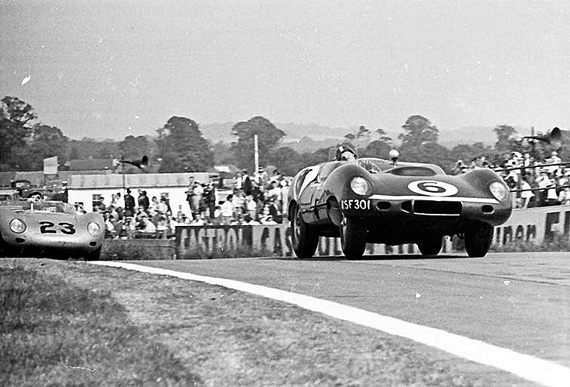
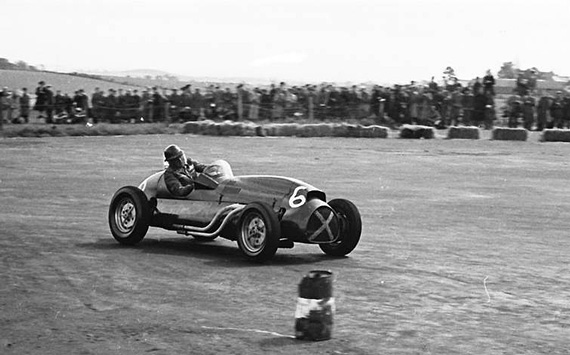
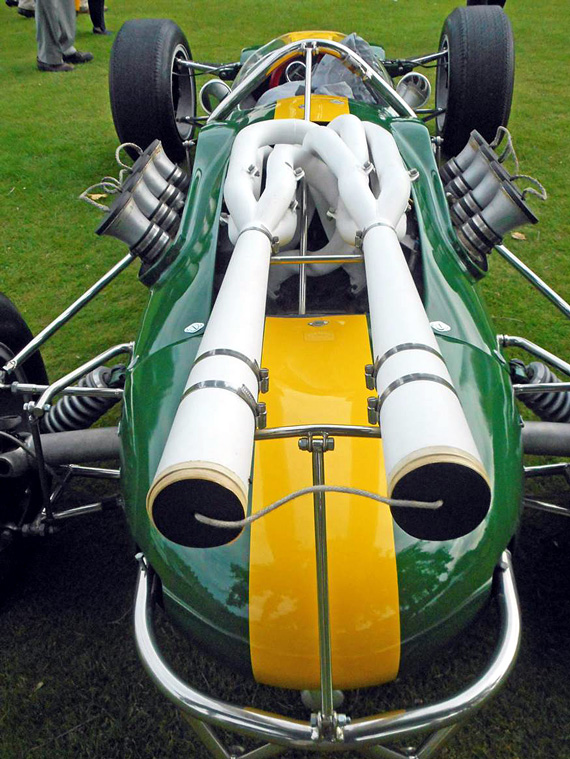
To Graham Gauld and to Pete Vack — Thanks for bringing us these great stories and pictures. — Carl Goodwin
I still have great memories of Jimmy Stewarts wonderful drive in the 1953 British Grand Prix, sadly ended when he spun off at Copse during the rain shower near the end of the race. He got a great reception from the appreciative spectators.
Being a spectator when Masten Gregory raced could be interesting at times as he would occasionaly end up loining you!. He was a fine driver though.
Gregory crash at Tourist Trophy, which led to his
not being accepted later in year at Sebring for Formula I race.
His works Cooper taken over by a young Bruce Mc Laren who
came along in case he was ” needed”. He turned out to be winner
at age 22, and Poor Gregory deprived of a possible Grand Prix win
that eluded him.
Jim Sitz
The reason the Tojeiro-Juguar was such a bear to drive, was that the car’s “AeroDramatics” are all wrong. The car has a long flat nose, with a long constant entre. that changes to an assigmetric fin. What you have with this car, is a laminar-flow wing that produces lift, and then in a yawl condistion, the lift unloads unevenly. The “up on its tip toes” quote from Jim Clark is the body producing lift. This of course leads to the car’s unstable conditions under different angles of attack while under acceleration and breaking.
Great article. Spotted a typo ” the Lotus 38 Indianapolis car that Clark ran in 1957″ – should be 1967?
Sorry, brain fade – the Lotus 38 won Indy in 1965.
Nice article. What was the address of the garages in Merchiston Mews?
Jim
I didn ‘t know that Masten had been banned from Sebring because of that crash. Though some people at the time found it amusing that he should choose to bail out not only then but on another occasion it was certainly the case that in some fatal racing accidents with sports cars the driver might have been saved if he had done the same thing.
Graham
Michael
Thank you for your description of the aerodynamics. The man who designed the bodywork and a number of other cars by John Tojeiro was Cavendish Morton best known as a seascape artist who was shown at the Royal Academy in London. He was an absolutely charming man and admitted that his designs were based on his artistic concept rather than technical aerodynamics. I fear that back then and before in the history of motor racing many of the aerodynamic ideas that we saw from time to time were conceived by the eye rather than by the mathematics.
Graham
Jim Clark: Everybody’s hero, especially the Scots!
Pete, One last word.. Some how I’m not surprised that an artist designed the Tojeiro Jaguar. The car is a thing of beauty and every school boys dream of what a racecar should look like. However the Tojeiro was one of serveal promising designs that failed due to bad aerodynamics. Case in point, the 1952 Le Mans C Jaguars. Before the overheating took them out, they were getting lots of lift on the straights, due to the long low tail design. But the worse example of bad aerodynamics was the Cunningham C5R. The car was blindingly fast (faster than the D-Jaguar), but the body was pure wing. It took off on Phil Walters in Florida testing, and then did the same to John Fitch at Rheims in 1953. Since the body looked right, they could not understand the forces at work. The design was abandon, and Cunningham went in a different direction. Aerodynamics in the 40’s and 50’s was about reducing drag. It wasn’t till Ritchie Ginther and Carlo Chiti put they heads together that the spoiler was born. Then came Jim Hall, who knocked the ball out of the park. The cars became less beautiful, but also less lethal.
Graham Gauld writes:
Anyone who claims to be a historian has to be on his toes to ensure that he makes as few mistakes as possible. However, in my report from the Concours of Elegance at Edinburgh’s Holyrood House in the September 15 issue of VeloceToday I referred to one of the Ecurie Ecosse D type Jaguars that had been badly damaged, was rebuilt in more recent years with half of one car and half of another D type.
In the story I was talking about Clive Beecham’s ex-Ecurie Ecosse D type Jaguar, XKD 603, and stated that it was part of this rebuild: it was not!
In the rush to compile the story I could not find my notes taken when the
1957 Ecurie Ecosse Le Mans Winning D type of Evert Louwman ( XKD 606) was taken to Prowess Engineering to have parts taken from Louwman’s other D type Jaguar XKD 602 to restore 606 to its original state.
Where the confusion arose was that back in 1956, when XKD 603 was one of the Jaguar factory team cars, it was crashed by Paul Frere. When it returned to the factory the front sub-frame was taken off and grafted on to another factory car, XKD 606 that had been crashed in practice at Le Mans that year.
This was a factory rebuild and after this piece of surgery the resultant car was renumbered XKD603 before being sold in 1957 by the factory to Ecurie Ecosse. Meanwhile the factory rebuilt XKD606 and sold it also to Ecurie Ecosse.
That year, 1957, XKD 603 finished second at Le Mans for Ecurie Ecosse with its sister car XKD 606 winning the race driven by Ron Flockhart and Ivor Bueb.
What happened next is a story of delusion.
When, in 1959, David Murray the patron of Ecurie Ecosse agreed to sell the actual Le Mans winning car (606) to James Munro in the United States he had a last minute change of heart. He got his chief mechanic to take off the front bodywork of 606, with a single white stripe on the front, and put it on to chassis 603 and add the number 3 of the winning car to complete the delusion.
Murray felt he should keep the real Le Mans winning car and so sold Munro the car that had actually finished second!
It is this car, 603, that Clive Beecham now owns and he can quite rightly claim that his factory-built car in period is probably the most original D type Jaguar around today.
As can be seen above, the provenance of race cars, can be a minefield which is not helped when an owner misrepresents the car he has sold. When that owner happened to be David Murray, the patron of Ecurie Ecosse, it makes it doubly painful.